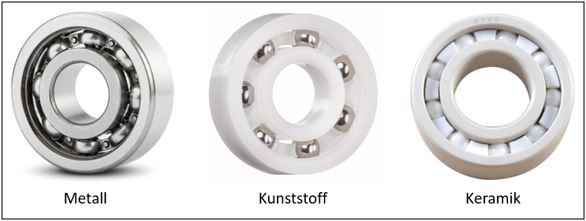When do I use a particular ball bearing? – Metal, plastic, ceramic
Patrick Czaja | 18. November 2019
Choosing the right material for ball bearings is not always easy. A short summary, when I use a particular ball bearing.
Limits of metallic ball bearings
Metallic ball bearings are mainly used in most classic mechanical engineering applications. They rank number 1 in terms of global sales volumes and are suitable for a large number of different mechanical engineering applications. However, you always come to the usage limit when more demands are made on the bearings, in addition to load bearing and speed. This applies, for example, to various sectors such as the food industry or medical technology. Specifications such as suitability for contact with food or suitability for use in cleanrooms are decisive here. To do so, equipment manufacturers often require a food certification according to EU standard 10/2011 or the FDA (American agency: Food and Drug Administration).
Plastic and its advantages
The advantage of plastic lies in the variety of materials. It is possible to choose different base polymers for the most diverse applications, which are precisely suitable for the application in terms of their specifications. In recent years, base polymers such as POM (polyoxymethylene), PP (polypropylene), PEEK (polyetheretherketone) and other plastics established themselves. Polymer ball bearings are suitable for the following industries and applications:
- Food industry (advantage food contact)
- Medical technology (advantage FDA conformity)
- Chemical industry (advantage chemical resistance)
- Textile industry (no adhesion of dirt and dust)
- Vacuum/High temperatures (no destruction of the lubricant)
- Special applications like MRI (magnetic resonance imaging) or metal detectors (advantage metal-free)
Ceramic bearings for extremely high temperatures
For plastics and ceramics, aqueous media such as lubricants. With an appropriate structural design, the coefficient of friction can be stabilised at a low level by 0.1 or even lower. The wear is very low, so that in general a very long service life is achieved. With regard to the load bearing and the achievable speed, both plastics and ceramics have disadvantages compared to metals. Regardless of the variety of metal materials, metals have a good combination of hardness and flexibility. Plastics, on the other hand, are much softer and can deform faster (especially at high temperatures). Although ceramics are very hard, they also have the lowest flexibility and can break quickly under impact loads. In addition, the heat dissipation of ceramic and plastic is less than of metal. Therefore, they are also limited in terms of the maximum achievable speed.
Also read: Do ball bearings actually have to be greased?


